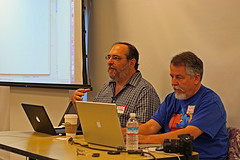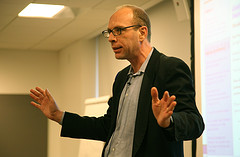SAN FRANCISCO — If you wondered what happens when bloggers get into a room together for a conference, the unsurprising truth is that they sit around and talk about blogging while simultaneously going on their laptops to blog about it. That’s the scene here at BloggerCon IV in the offices of CNET Networks in the South of Market neighborhood in San Francisco. (The San Francisco dateline here is a bit of a lark, as almost all my writing should be datelined here where I live; but it looks nice.)
BloggerCon is the brainchild of blog pioneer and programmer Dave Winer (pictured here with Doc Searls), who held the first BloggerCon in Cambridge, Mass., in September 2003. The style of this meeting goes counter to most conferences beyond the fact that so many people are blogging it. It’s known as the unconference, where there are no panels and the audience participates and drives each session with a discussion leader (DL) moderating. It’s like a geeky town hall meeting.

BloggerCon is also completely non-commercial. It costs nothing to attend, there are no corporate sponsors, and there is no trade show floor with booths and people hawking products. No one is allowed to tout a product that they sell during the discussions, but of course with each comment in the discussion you can tout your own blog. The unconference has a nice loose feel to it because of the removal of speeches, technology demos, and panels.
At this early hour (about 9:15 am Pacific Time), the room at CNET is about half full with the participants tending to be older white males (like myself). In the opening session, Winer welcomed everyone to the conference, and tried to get people to come up with a theme song. “Feelings” and “All You Need Is Love” were shot down, but “The Hokey Pokey” scored and had a good number of people up on their feet dancing around.
Someone noted that a lot has changed in the blogosphere over the past 18 months, with the rise of MySpace and the blogging space Live Journal and other blogs-for-the-masses. Winer mentioned that New Orleans was basically destroyed in that time as well, and was happy that there was a sound system in the room to pipe in New Orleans jazz during session breaks.
The weird thing about live-blogging a conference is that you are multi-tasking on many levels. You are in a room with a laptop on your lap, typing away about what you hear and see. You might snap a digital photo of your fellow participants. But when do you stop blogging and join the discussion going on? And how do you read all the other blogs that people are writing who are sitting right next to you?
The first session is titled simply “Tools” and it’s letting everyone get their geek out. The talk bounces around into the technical details of blogging and podcasting, from the enhanced podcast format to Sony mini-disc players to an in-ear binaural mike. There’s a brief debate over whether mainstream media people “get” the technology and are open to blogging and other new tools.

The second session is about journalism, with NYU professor and blogger Jay Rosen (picture here) as discussion leader. Rosen seeded the discussion in advance on his PressThink blog, and then put up on the screen some of the questions he wanted to have the audience help answer for him.
Among those questions:
- How do you tap into distributed knowledge — the idea that the audience knows more than the journalist — to improve journalism and do investigative journalism.
- What are some new cases of “open source journalism,” where a large group of average folks help report a complex story online?
- What kinds of stories lend themselves to broadly distributed networks of people?
- Which types of communities should we tap into for these efforts, or should we create a new community from scratch?
Some of the ideas that Rosen shared were fascinating examples of what was possible. He mentioned a blog-organized non-partisan coalition of citizen volunteers who explain the text of every bill before the U.S. Congress. Or a way to figure out the actual prices consumers pay for commonly used prescription drugs around the world. Or an effort to hold Wal-Mart accountable if the large chain says it has reformed labor practices at its stores.
Ken Sands, who runs the online operations at the Spokane (Wash.) Spokesman-Review, said he was at the conference in order to take more ideas back to his newspaper. His site already has 35 blogs and three or four podcasts, and they webcast their two daily news meetings to the world online. “My editor told me to come back with tradition-busting ideas,” Sands said.
Then people started to share their ideas. Someone mentioned the Sunlight Foundation, a group that’s trying to harness the power of the Internet to hold the Congress accountable. One high-profile project by Sunlight is its Congresspedia, which lets everyone edit a wiki about the workings in Congress.
Another example mentioned was the Starbucks Challenge, where bloggers were holding the coffee chain to its promise to offer fair trade coffee at all its stores.
So how do you motivate people to do this investigative work? There’s not a lot of money to pay them. Christopher Carfi noted that people like seeing their name in the newspaper so giving them prominent credit would help.
Media consultant Terry Heaton had an interesting comment about this new way of doing journalism.
“How do we do postmodern news?” Heaton asked. “I think it’s the opposite of what we do now. Even the word ‘story’ is wrong, because it presupposes that the storyteller knows more than everyone else. It won’t look like a beginning-middle-end narrative. You’ll have many pieces of information to pull together. The problem with where we are in history is that we’re trained as modernists. Listening is where it starts and being open-minded and fluid and open to change.”
While the people at BloggerCon had a lot of interesting comments and suggestions on how to do these types of projects, many people couldn’t quite understand the type of project Rosen was proposing. They thought he was talking about bloggers ganging up to tackle problems, or ways the mainstream media could improve their reporting.
In the end, Rosen told me he felt frustrated about the session, but that he had a better understanding of the problems facing him in trying to create a new way of doing open source journalism.
“Now I know what the challenges are going to be,” he said. “If you get people to contribute, what do you do with that information? How do you organize it, verify it? Those are huge problems. If you get people who are motivated and you succeed on getting them to contribute something, then that creates more problems.”
[Photo of Dave Winer and Doc Searls taken by Niall Kennedy. Photo of Jay Rosen taken by Scott Beale.]
